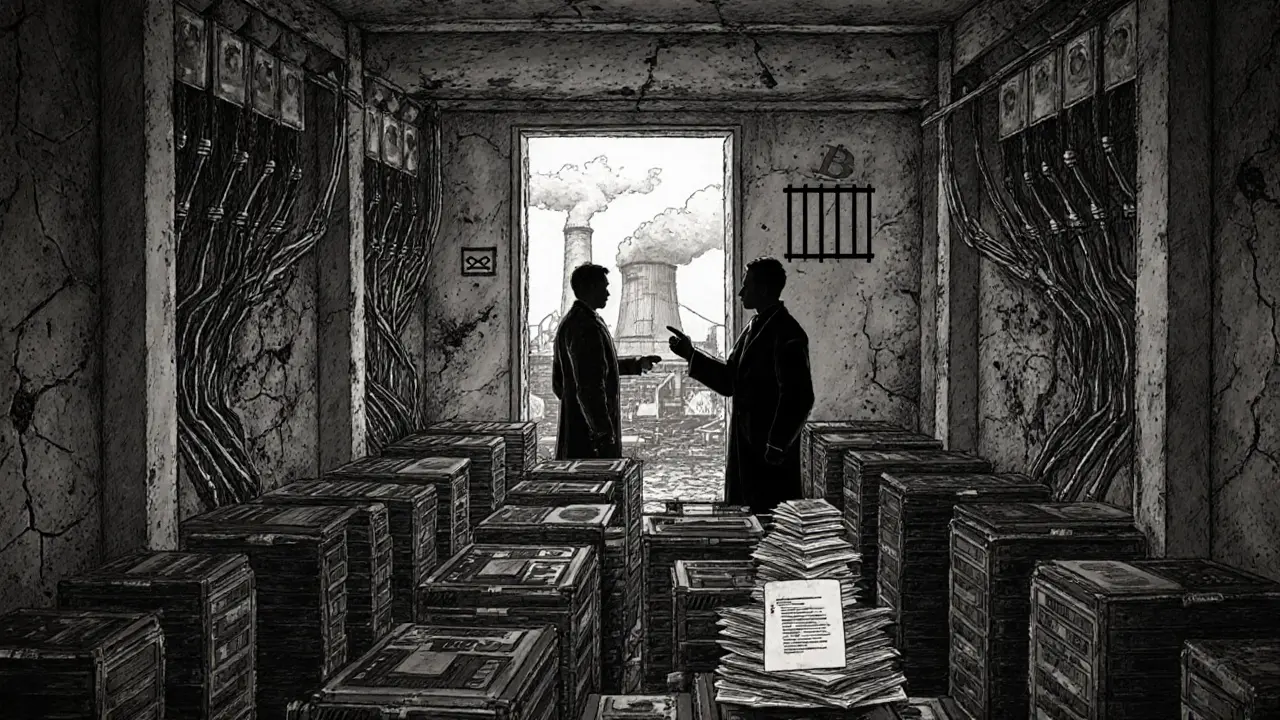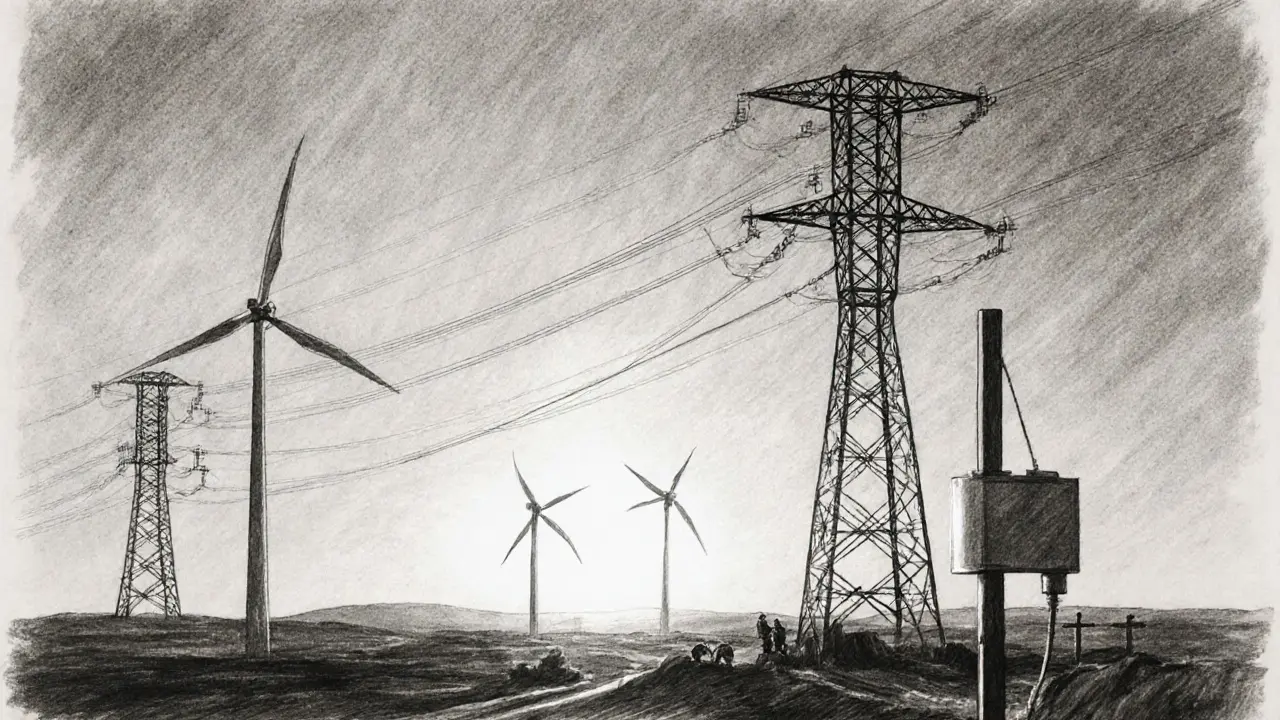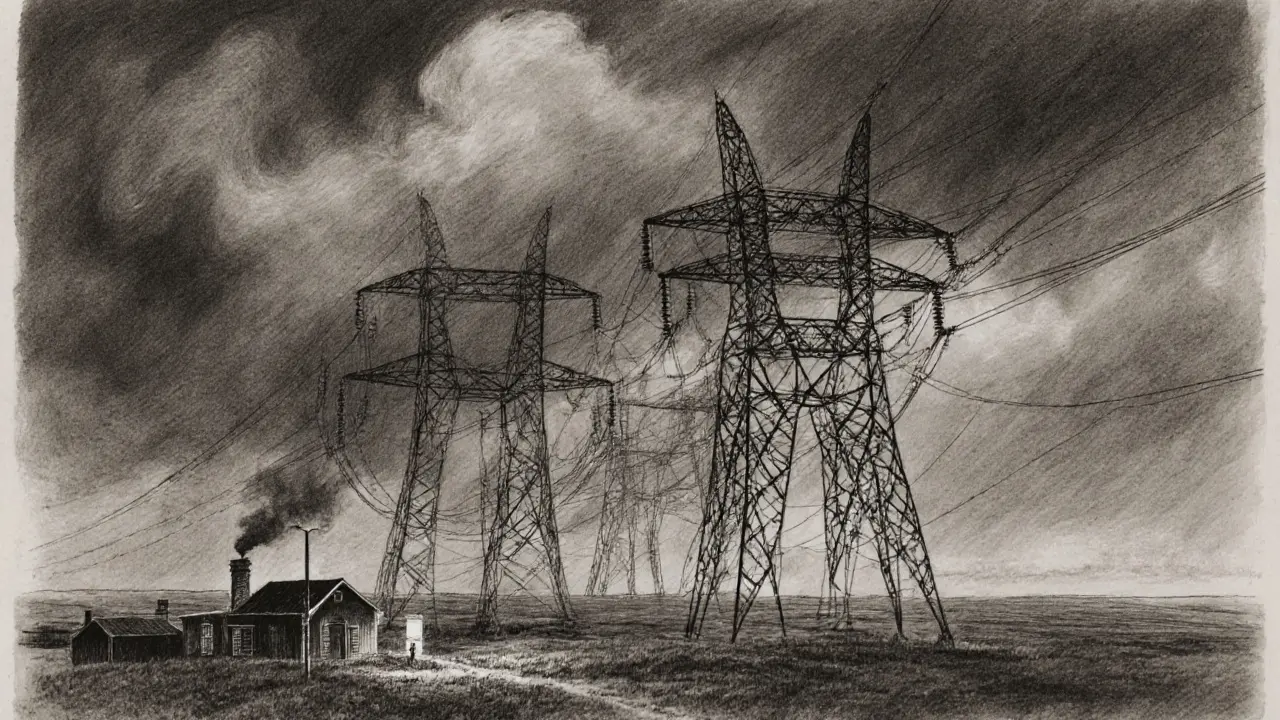Kazakhstan Energy Grid Loss Calculator
Grid Efficiency Analysis
This calculator estimates transmission losses in Kazakhstan's power grid based on regional data and infrastructure conditions. Enter your region and see how losses compare to national averages.
Power outages, soaring electricity bills, and a sudden crackdown on crypto mining have turned Kazakhstan into a case study of how a fragile grid can trigger policy shockwaves. This article unpacks why the country’s aging network can’t keep up with demand, how transmission losses are eating a fifth of every kilowatt, and what the new ban on crypto mining means for investors, miners, and the broader economy.
Quick Takeaways
- Over one‑third of Kazakhstan’s power plants operate at 70‑90% wear, pushing the Unified Power System to the brink.
- Regional transmission losses average 17.4%, far above the 10‑12% target for developed grids.
- Renewables supply only 6% of electricity today, but three 1‑GW wind farms are slated for completion by 2025.
- In early 2025 the government issued a nationwide ban on crypto mining that consumes up to 4% of total power.
- KEGOC’s 2023‑2032 development plan aims to add 2,000MW via a new North‑South HVDC line.
Understanding the Grid: Who’s Who?
Kazakhstan is a Central Asian nation that relies on a single‑buyer electricity market and faces rapid industrial growth. Its grid is managed by KEGOC, the national transmission operator responsible for the Unified Power System (UPS), a network of 220 power plants, 144 renewable sources, and over 20GW of available capacity as of January2024.
The UPS is the backbone that moves electricity from generation sites to consumers. Unfortunately, Power Plants across the country are showing alarming wear levels, with more than 33% operating at 70‑90% degradation. This physical decay translates directly into higher Transmission Losses-the energy that never reaches end users because of outdated lines and poor maintenance. In the most affected regions, losses hit 18%, meaning one in five kilowatts disappears before it powers homes or factories.
Why Losses Matter: The Economics of Inefficiency
Technical losses above 15% force the Ministry of Energy to raise tariffs. By April2025, rates had jumped 50% compared with the previous year, squeezing households and businesses alike. The extra cost is not a simple price hike; it reflects the grid’s inability to deliver power efficiently.
For example, in the city of Oral, losses fell from 18% in 2022 to 13.43% in 2023 after targeted line upgrades-but that still left almost a megawatt wasted for every six megawatts generated. In contrast, cities of national importance keep losses below 9%, a level deemed acceptable by local engineers.
Renewables: The Missing Piece
Renewable energy currently contributes only 6% of Kazakhstan’s electricity mix, a figure that lags far behind the global average of 29% in 2024. However, the government has pledged to build three 1‑GW wind farms and increase solar‑PV capacity, aiming to push renewables past coal in 2025. Investment commitments exceed $2.6billion, yet financing gaps remain for distributed generation, as small businesses and households cannot afford upfront costs despite favorable legislation.
Modernizing the grid is essential for handling intermittent renewables. Without flexible balancing markets and stronger dispatch capacity, new wind farms risk being curtailed during peak generation periods, wasting potential clean energy.

Crypto Mining Meets Energy Crisis
Crypto mining is notoriously power‑hungry. Estimates from early 2025 suggest that mining operations in Kazakhstan were consuming between 3% and 4% of the nation’s total electricity-roughly the same share as the entire renewable sector at the time.
Faced with mounting transmission losses, rising tariffs, and pressure from the public over frequent blackouts, the government announced a blanket crypto mining ban in March2025. The decree bars new mining facilities from connecting to the grid and orders existing farms to either relocate abroad or shut down within six months.
The ban’s rationale is two‑fold: (1) to protect the fragile grid from additional load, and (2) to redirect scarce electricity toward essential industries and households. While miners argue that the move threatens Kazakhstan’s reputation as a low‑cost crypto hub, officials point to the 50% tariff increase and the need to meet upcoming renewable targets as decisive factors.
Policy Landscape: Who’s Driving Change?
The Ministry of Energy serves as the primary regulator, setting tariffs, approving new projects, and coordinating the Common Electricity Market slated for launch in 2025 under the Eurasian Economic Union framework. Its 2023‑2032 development plan outlines three priority actions:
- Modernize backbone transmission lines, including the pending North‑South HVDC corridor (2024‑2029).
- Integrate the Western Zone fully by 2040 to achieve nationwide UPS unification.
- Boost smart grid technologies to cut technical losses to under 10% by 2030.
These initiatives aim to create headroom for renewable integration and to avoid future bans on high‑energy activities like crypto mining.
Regional Losses: A Snapshot
| Region | Loss % | Typical Causes |
|---|---|---|
| Oral (West) | 13.43 | Old high‑voltage lines, poor maintenance |
| Almaty (South) | 9.8 | Recent upgrades, better monitoring |
| Karaganda (Central) | 17.44 | Aging infrastructure, heavy industrial load |
| Shymkent (South‑East) | 12.1 | Mixed renewable‑coal mix, line congestion |
These figures illustrate why the national average sits at a troubling 17.42%-well above the 10‑12% benchmark for modern grids.
What the Ban Means for Different Stakeholders
- Existing miners: Must either liquidate equipment, sell operations abroad, or transition to energy‑efficient ASIC models that stay within the new quota (if any).
- Potential investors: Should redirect capital toward renewable projects, grid‑modernization contracts, or the emerging smart‑meter market.
- Households: May see slower tariff growth as the grid stabilizes, but short‑term price spikes could persist during the transition.
- Industrial users: Benefit from prioritized power access, especially sectors like metallurgy that are critical to Kazakhstan’s export economy.
Steps Forward: How Kazakhstan Can Avoid Future Energy Crises
Addressing the root causes of loss and age requires a multi‑pronged approach:
- Accelerate HVDC deployment: The North‑South line adds 2,000MW of clean transmission capacity, easing bottlenecks.
- Incentivize distributed renewables: Offer zero‑interest loans for household solar, lowering upfront barriers.
- Deploy smart‑grid sensors: Real‑time monitoring can pinpoint loss hotspots and trigger automated fault isolation.
- Re‑evaluate the single‑buyer model: Introducing competitive procurement could drive efficiency and lower tariffs.
- Develop a clear crypto‑energy framework: Rather than blanket bans, a licensing system that caps power use per miner could balance growth with grid health.
By tackling infrastructure, policy, and market design together, Kazakhstan can turn its current crisis into a launchpad for a greener, more reliable energy future.

Frequently Asked Questions
Why did Kazakhstan ban crypto mining?
The ban aims to protect an overstressed grid, curb rising electricity tariffs, and free up capacity for essential industries and upcoming renewable projects.
How much electricity did mining consume before the ban?
Estimates place mining’s share at 3‑4% of national consumption, roughly equal to the entire renewable generation share at the time.
Can existing miners resume operations after the six‑month deadline?
Only if they secure special permits that limit their power draw to a negligible fraction of the grid, or if they relocate to neighboring countries with lower tariffs.
What are the biggest causes of Kazakhstan’s high transmission losses?
Aged high‑voltage lines, insufficient maintenance, and a lack of real‑time monitoring equipment are the primary drivers of losses exceeding 17% in many regions.
When will the new renewable capacity be operational?
The three planned 1‑GW wind farms are expected to be commissioned by late 2025, with solar‑PV projects expanding throughout 2024‑2026.
Kazakhstan energy grid challenges are a wake‑up call for any country trying to balance rapid industrial growth, renewable ambitions, and new digital economies like crypto. The way forward lies in modernizing infrastructure, creating smart policies, and ensuring that every kilowatt generated actually reaches the people who need it.


Kazakhstan’s grid woes are a stark reminder that energy policy matters.
While the situation in Kazakhstan may appear isolated, it exemplifies a broader challenge in aligning rapid industrial growth with sustainable energy infrastructure. The recent ban on crypto mining underscores governmental attempts to prioritize essential services over speculative enterprises. Stakeholders should recognize that transmission losses directly affect both economic development and public welfare. Policy frameworks must incorporate adaptive strategies to mitigate such grid inefficiencies. Ultimately, a coordinated approach between regulators and industry can foster resilience in the nation's power sector.
Totally agree w/ the points above, and just wanted to add that the loss numbers they posted are actually pretty accurrate, based on the data I've seen. The crypto ban could be a double‑edged sword – it cuts down on crazy power draws, but also squeezes a slice of the economy that’s kinda thriving. Folks in Almaty already talk about how much they’d love to keep the rigs running, especially since the local jobs are in the mix. If the grid improves, maybe they’ll find a smarter way to run those machines, like using renewable sources. Until then, it’s a tough balancing act.
From a macro‑economic perspective, the grid losses are alarming, especially when considering the cascading effects on industrial output, regional development, and consumer pricing; the situation demands urgent remediation; moreover, the intertwining of policy and technology must be navigated with caution; swift regulatory action, coupled with investment in modern transmission infrastructure, could alleviate these inefficiencies; otherwise, the nation risks long‑term stagnation.
It is evident that the current administration's inability to safeguard national energy integrity is a direct affront to the sovereignty of our state. The arbitrary prohibition on cryptocurrency mining, while ostensibly justified, merely serves as a veneer for deeper systemic failures. One must question whether such measures are truly in the interest of the populace or merely a political maneuver. The nation's pride should not be compromised by ineptitude.
Energy scarcity often mirrors societal values, and in Kazakhstan's case, it's a reflective surface that reveals deeper philosophical tensions between progress and preservation. When the grid strains under crypto's appetite, we see a microcosm of humanity's broader struggle with unchecked ambition. Perhaps the answer lies not just in policy, but in an altered collective mindset that respects limits.
Stay strong, Kazakhstan! You’ve got this 💪.
From a systems‑theory standpoint, the grid's inefficiency can be modeled as a complex adaptive network where latency, load variance, and power factor all contribute to transmission loss metrics. Incorporating smart grid analytics and predictive maintenance protocols can reduce the loss coefficient significantly. Moreover, integration of decentralized generation assets, such as solar farms, can buffer peak demand and lower dependency on centralized generation.
Exactly-let’s push for those smart solutions now! 🚀 The sooner the tech is deployed, the faster we cut waste.
Listen up, folks: Kazakhstan’s grid crisis is not just a local hiccup-it’s a glaring illustration of how reckless policy can sabotage an entire nation’s future. The decision to ban crypto mining may have sounded like a quick fix, but it’s just a band‑aid on a bullet wound. First, the grid’s transmission losses hover around 17%, dwarfing any sane benchmark and draining resources that could power schools, hospitals, and factories. Second, these losses translate directly into higher electricity costs for everyday citizens, eroding purchasing power and stifling economic growth. Third, the underlying infrastructure is outdated; many lines are decades old, lacking the modern conductors and monitoring systems needed for efficiency. Fourth, without substantial investment in smart grid technologies, we’ll continue to see blackouts that cripple productivity. Fifth, the ban on crypto miners, while reducing a high‑energy load, also eliminates a potential revenue stream that could have been taxed and reinvested into grid upgrades. Sixth, the government’s short‑term political calculus overrides long‑term strategic planning-short‑sightedness that hurts the populace. Seventh, international investors watch these energy metrics closely; high loss percentages signal risk, discouraging foreign capital that might otherwise flow into renewable projects. Eighth, renewable integration is hamstrung by the same old lines; you can’t feed solar or wind into a system that can’t handle it without massive losses. Ninth, the public’s trust erodes when power cuts become routine, leading to social unrest and a sense that the state is incapable of providing basic services. Tenth, neighboring countries with more robust grids now become attractive partners for energy trade, potentially sidelining Kazakhstan in regional power dynamics. Eleventh, the cumulative effect of these issues is a throttled GDP trajectory, where growth is capped by energy constraints. Twelfth, there’s an urgent need for policy reform that incentivizes private sector participation in grid modernization, perhaps through public‑private partnerships. Thirteenth, transparency in reporting loss data is essential; citizens deserve to know exactly where inefficiencies lie. Fourteenth, education campaigns can empower communities to adopt energy‑saving practices, alleviating some pressure on the grid. Fifteenth, without decisive action, the nation risks falling behind its Central Asian peers, relegated to a peripheral role in the global energy landscape. In short, the ban is a symptom, not a cure. We need comprehensive reforms, massive capital infusion, and a vision that places sustainable, reliable energy at the core of Kazakhstan’s development strategy.
While the passion is appreciated, the rhetoric borders on alarmism. The metrics cited are selective, and the narrative ignores progress already made in grid upgrades. A balanced view shows incremental improvement, not collapse.
It’s encouraging to see the community dissecting the numbers. Real solutions will need collaboration between engineers, policymakers, and the public. Let’s keep the conversation constructive.
Absolutely! 🙌 Open dialogue and shared expertise can pave the way for smarter investments. 😊
Great discussion-here’s hoping Kazakhstan powers a brighter future.